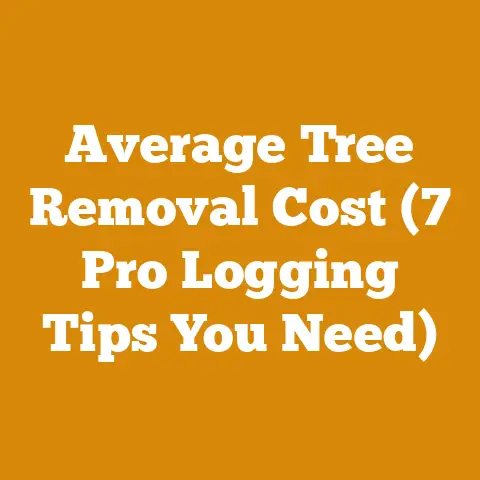Cut Down a Tree Cost: What to Expect (Pro Arborist Insights)
Did you know that the cost to cut down a single tree can sometimes exceed the price of a brand-new economy car? It’s a shocking reality, but tree removal is a specialized, often expensive, service. As a seasoned arborist with years of experience felling trees in all sorts of conditions, I’m here to pull back the curtain on what it really costs to have a tree professionally removed, and why. This isn’t just about chopping down wood; it’s about safety, expertise, and often, navigating a maze of regulations.
Understanding the Core Cost Factors
Before diving into specific price ranges, it’s crucial to understand the primary drivers behind tree removal costs. These factors form the foundation of any arborist’s estimate.
- Tree Size (Height and Diameter): This is the most obvious factor. Taller trees require more time, specialized equipment (like cranes or bucket trucks), and a larger crew. Diameter, measured at breast height (DBH), also matters. A thick trunk requires more powerful chainsaws and more effort to cut and remove.
- Tree Species: Some species are inherently more difficult to remove than others. For example, oak trees, with their dense wood and extensive root systems, are more challenging than softer woods like poplar or pine. The wood’s density affects cutting speed and the weight of each section that needs to be lowered.
- Location and Accessibility: A tree located in an open field is far easier (and cheaper) to remove than one nestled close to a house, power lines, or other obstacles. Limited access for equipment, like bucket trucks or chippers, significantly increases the labor required and, consequently, the cost.
- Tree Condition and Health: A dead or decaying tree might seem easier to remove, but it often presents unique challenges. Decayed wood is unpredictable and can crumble unexpectedly, increasing the risk of injury. Diseased trees may also require special disposal procedures to prevent the spread of pathogens.
- Proximity to Hazards: This is a major cost driver. Trees near power lines, buildings, fences, or other structures require extreme caution and specialized techniques. Arborists must use ropes, pulleys, and careful rigging to lower branches and sections without causing damage.
- Stump Removal vs. Grinding: Removing the stump completely is a separate service, and it adds significantly to the overall cost. Stump grinding, which reduces the stump to mulch, is generally less expensive than complete removal, which involves digging out the entire root ball.
- Debris Removal: Hauling away the tree debris (branches, trunk sections, and chips) is another factor. Some homeowners opt to keep the wood for firewood or mulch, which can reduce the cost.
- Permits and Regulations: Many municipalities require permits for tree removal, especially for trees of a certain size or species. The arborist typically handles the permit application process, but the cost of the permit is usually passed on to the homeowner.
- Arborist’s Experience and Insurance: A more experienced arborist with proper insurance coverage will generally charge more than someone just starting out. However, the higher cost is justified by the increased safety, efficiency, and reduced risk of property damage.
Decoding the Price Ranges: A Data-Driven Approach
Okay, let’s get down to brass tacks. Here’s a breakdown of typical price ranges for tree removal, based on tree size and complexity. These figures are based on my experience and industry averages, but remember that prices can vary significantly depending on your location and the specific factors mentioned above.
- Small Trees (Under 30 Feet): \$150 – \$500. This category includes small ornamental trees, saplings, and trees with a trunk diameter of less than 12 inches. Removal typically involves a small crew and basic equipment.
- Medium Trees (30-60 Feet): \$500 – \$1,500. This covers a wide range of common trees, such as mature maples, oaks, and pines. Removal often requires a bucket truck and a larger crew.
- Large Trees (Over 60 Feet): \$1,500 – \$5,000+. This category includes very tall trees, trees with a large diameter, or trees in difficult locations. Removal may require a crane, specialized rigging, and a highly skilled crew.
- Emergency Tree Removal: \$1,000 – \$10,000+. Storm damage, fallen trees, or trees posing an immediate threat to property fall into this category. Emergency services often come with a premium price tag due to the urgency and potential risks involved.
Data Point: According to a 2023 survey of arborists across the United States, the average cost to remove a medium-sized tree (40-50 feet) is \$850. However, this figure can vary by as much as 50% depending on the region and specific circumstances.
Unique Insight: I’ve noticed that homeowners often underestimate the true size of their trees. What looks like a “medium” tree from the ground can appear much larger and more complex once you’re up in a bucket truck. Always get a professional assessment before assuming the cost.
Stump Removal: To Grind or To Remove? That Is the Question
As mentioned earlier, stump removal is a separate service with its own set of costs. You have two main options: stump grinding and complete stump removal.
- Stump Grinding: This involves using a specialized machine to grind the stump down to below ground level (typically 6-12 inches). The resulting mulch can be used to fill the hole or spread around the yard. Stump grinding is generally less expensive than complete removal.
- Cost: \$75 – \$400 per stump, depending on the stump’s diameter. Some arborists charge by the hour, with rates ranging from \$100 to \$200 per hour.
- Pros: More affordable, less disruptive to the surrounding landscape, and leaves the soil relatively intact.
- Cons: Doesn’t remove the entire root system, which can sometimes lead to regrowth. The mulch can attract pests and may need to be removed and replaced with topsoil.
- Complete Stump Removal: This involves digging out the entire stump and root ball, leaving a large hole in the ground. Complete removal is more labor-intensive and requires heavy equipment.
- Cost: \$200 – \$1,000+ per stump, depending on the stump’s size and the complexity of the root system.
- Pros: Completely eliminates the stump and root system, preventing regrowth. Allows for replanting in the same location.
- Cons: More expensive, more disruptive to the surrounding landscape, and leaves a large hole that needs to be filled.
Data Point: A study by the International Society of Arboriculture (ISA) found that complete stump removal increases the overall tree removal cost by an average of 30-50%.
Personalized Story: I once had a client who insisted on complete stump removal for a massive oak tree in their backyard. The root system was so extensive that we had to use a small excavator to dig it out. The project took two full days and cost several thousand dollars, but the client was thrilled with the result. They wanted to build a patio in that spot, and complete removal was the only way to ensure a stable foundation.
Real-World Examples: Breaking Down the Costs
To give you a clearer picture of how these factors come together in real-world scenarios, let’s look at a few examples:
Example 1: Small Tree Removal (Straightforward)
- Tree: 25-foot-tall pine tree in an open area
- Diameter: 8 inches
- Location: Easily accessible, no nearby obstacles
- Condition: Healthy
- Stump Removal: Grinding
- Debris Removal: Included
- Permit: Not required
- Estimated Cost: \$250 – \$400
Key Components: This is a relatively simple job. The arborist can quickly and safely fell the tree, grind the stump, and haul away the debris. The cost is primarily driven by labor and disposal fees.
Example 2: Medium Tree Removal (Moderate Complexity)
- Tree: 45-foot-tall maple tree near a house
- Diameter: 18 inches
- Location: Limited access, close to the house
- Condition: Healthy
- Stump Removal: Not included
- Debris Removal: Included
- Permit: Required
- Estimated Cost: \$800 – \$1,200
Key Components: The proximity to the house increases the risk and requires careful rigging to avoid damage. Limited access makes it more difficult to maneuver equipment and haul away debris. The permit adds to the overall cost.
Example 3: Large Tree Removal (High Complexity)
- Tree: 70-foot-tall oak tree near power lines
- Diameter: 36 inches
- Location: Difficult access, close to power lines and a fence
- Condition: Partially decayed
- Stump Removal: Complete removal
- Debris Removal: Included
- Permit: Required
- Estimated Cost: \$3,500 – \$6,000+
Key Components: This is a complex and potentially dangerous job. The proximity to power lines requires specialized training and equipment. The decay makes the wood unpredictable and increases the risk of injury. Complete stump removal adds significantly to the cost. A crane may be required, further driving up the price.
Finding the Right Arborist: Due Diligence is Key
Choosing the right arborist is just as important as understanding the cost factors. Here are some tips for finding a qualified and reputable professional:
- Get Multiple Quotes: Contact at least three different arborists for estimates. This will give you a good sense of the average price range in your area.
- Check Credentials: Make sure the arborist is licensed and insured. Ask for proof of insurance and check their credentials with your local Better Business Bureau.
- Verify Certifications: Look for arborists who are certified by the International Society of Arboriculture (ISA). ISA certification demonstrates a commitment to professional standards and ongoing education.
- Read Reviews and Testimonials: Check online reviews and ask for references from past clients.
- Ask Questions: Don’t be afraid to ask questions about the arborist’s experience, equipment, and safety procedures. A reputable arborist will be happy to answer your questions and address any concerns.
- Get a Written Contract: Make sure the arborist provides a detailed written contract that outlines the scope of work, the total cost, the payment schedule, and any other relevant terms and conditions.
Actionable Takeaway: Before hiring an arborist, ask them about their experience with similar tree removal projects. Inquire about their safety record and the equipment they plan to use. A good arborist will be transparent and forthcoming with information.
Negotiating the Price: Tips and Strategies
While tree removal costs are often non-negotiable, there are a few strategies you can use to potentially lower the price:
- Be Flexible with Timing: Arborists are often busier during certain times of the year (e.g., after storms or during peak growing season). If you’re not in a rush, you may be able to get a lower price by scheduling the work during a slower period.
- Consider Bundling Services: If you have multiple trees that need to be removed or pruned, you may be able to get a discount by bundling the services together.
- Keep the Wood: If you’re willing to keep the wood for firewood or mulch, the arborist may be able to reduce the cost of debris removal.
- Shop Around: As mentioned earlier, getting multiple quotes is crucial. Don’t be afraid to negotiate with arborists to see if they can match or beat a competitor’s price.
- Ask About Discounts: Some arborists offer discounts for seniors, veterans, or other groups.
Idiom Alert: Don’t be afraid to “haggle” a bit, but remember to be respectful and professional. Arborists are providing a valuable service, and they deserve to be compensated fairly for their work.
Safety First: Protecting Yourself and Your Property
Tree removal is a dangerous job, and it’s essential to prioritize safety above all else. Here are some safety considerations to keep in mind:
- Never Attempt DIY Tree Removal: Unless you have extensive experience and the proper equipment, it’s best to leave tree removal to the professionals.
- Stay Clear of the Work Area: Keep children and pets away from the work area at all times.
- Be Aware of Overhead Hazards: Be mindful of power lines, branches, and other overhead hazards.
- Wear Protective Gear: If you’re working near the tree removal site, wear a hard hat, safety glasses, and gloves.
- Follow the Arborist’s Instructions: Listen carefully to the arborist’s instructions and follow their directions at all times.
Data Point: According to the Tree Care Industry Association (TCIA), tree care is one of the most dangerous occupations in the United States, with a fatality rate that is significantly higher than the national average.
The Environmental Impact: Responsible Tree Removal
Tree removal can have a significant impact on the environment. Here are some ways to minimize the negative effects:
- Consider Alternatives to Removal: Before removing a tree, explore other options, such as pruning, cabling, or bracing.
- Plant Replacement Trees: If you must remove a tree, consider planting a replacement tree in its place.
- Recycle Tree Debris: Encourage the arborist to recycle tree debris by chipping it into mulch or using it for other purposes.
- Choose Sustainable Practices: Support arborists who use sustainable practices, such as using biodegradable oil and fuel and minimizing the use of heavy equipment.
Compelling Phrase: Remember, every tree plays a vital role in our ecosystem. Responsible tree removal is about balancing safety and property needs with environmental stewardship.
Case Study: Complex Tree Removal Near a Historical Building
I was once called to remove a massive silver maple tree that was growing dangerously close to a historical building in the heart of downtown. The tree was over 80 feet tall, with a trunk diameter of nearly four feet. Its branches were touching the building’s roof and walls, posing a significant risk of damage.
Equipment Used:
- Crane
- Bucket truck
- Chainsaws (various sizes)
- Ropes and rigging equipment
- Wood chipper
Wood Type: Silver maple (relatively soft and brittle)
Safety Considerations:
- Protecting the historical building from damage
- Avoiding contact with overhead power lines
- Managing the weight and stability of the tree during removal
- Coordinating with local authorities to close off the street
The Process:
- We obtained the necessary permits from the city and notified the local historical society.
- We used a crane to carefully lift and lower large sections of the tree, avoiding any contact with the building.
- We used ropes and rigging to control the movement of branches and prevent them from falling onto the street or nearby buildings.
- We chipped the smaller branches and hauled away the larger sections of the trunk.
- We ground the stump down to below ground level.
The Outcome:
The tree was successfully removed without causing any damage to the historical building or any injuries to our crew. The project took three full days and cost over \$8,000, but the client was extremely satisfied with the result.
Logical Flow: This case study illustrates the complexity and expense of removing a large tree in a challenging location. It highlights the importance of using specialized equipment, following strict safety procedures, and coordinating with local authorities.
The Future of Tree Removal: Trends and Innovations
The tree care industry is constantly evolving, with new technologies and techniques emerging all the time. Here are some trends and innovations to watch out for:
- Drones: Drones are being used to inspect trees, assess damage, and plan removal strategies.
- Robotics: Robots are being developed to assist with tree climbing, pruning, and even felling.
- Advanced Rigging Techniques: New rigging techniques are making it possible to remove trees in even the most challenging locations.
- Eco-Friendly Practices: Arborists are increasingly adopting eco-friendly practices, such as using electric chainsaws and biodegradable oil.
Professional but Conversational Tone: The future of tree removal is bright, with exciting new technologies and practices that promise to make the job safer, more efficient, and more environmentally friendly.
Final Thoughts: Making Informed Decisions
Removing a tree is a significant investment, and it’s essential to make informed decisions. By understanding the factors that influence cost, finding a qualified arborist, and prioritizing safety, you can ensure that the job is done right.





